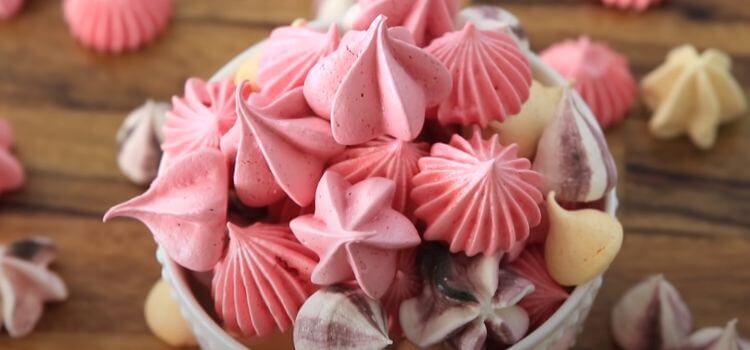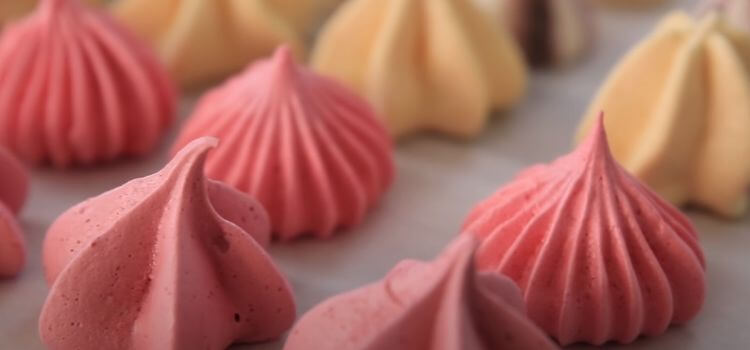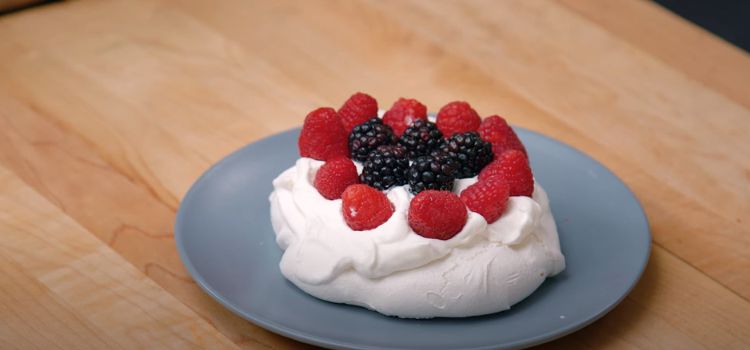As an Amazon Associate I earn from qualifying purchases.
Meringue, a delicate and airy concoction made from beaten egg whites and sugar, has long been a staple in countless kitchen creations. From beautifully piped decorations atop cakes to light and fluffy pie toppings, this versatile ingredient adds elegance and sweetness to a variety of desserts.
However, have you ever wondered if a blender could be used to whip up this divine treat? In this article, we will delve into the world of meringue and explore whether a blender can indeed be the secret weapon for creating this beloved confection.
So, let’s embark on this culinary investigation and find out if the blender has what it takes to produce the perfect meringue.
Overview of Traditional Meringue Preparation:

Meringue is a classic dessert component known for its light and fluffy texture. Traditionally, it is made by whisking egg whites and sugar until they form stiff peaks.
This process creates a stable foam, which is then baked to achieve a crisp exterior and a soft, marshmallow-like interior.
To make traditional meringue, you will need a few key ingredients: egg whites, sugar, and optionally, cream of tartar or lemon juice. Egg whites are the main component of meringue, providing the structure and volume.
Sugar is added to sweeten the meringue and stabilize the whipped egg whites. Cream of tartar or lemon juice can be used to stabilize the meringue further, preventing it from collapsing during baking.
The equipment required for making traditional meringue includes a clean mixing bowl, an electric mixer or handheld whisk, and a baking sheet lined with parchment paper.
It is crucial to ensure that the mixing bowl and whisk are completely clean and free from any grease or residue, as even the tiniest amount can prevent the egg whites from properly whipping.
The technique for making meringue involves a step-by-step process. Start by separating the egg whites from the yolks, being careful not to get any yolk into the whites.
Place the egg whites in the clean mixing bowl and begin beating them on low speed until they become frothy. At this stage, you can add cream of tartar or lemon juice to help stabilize the meringue.
Once the egg whites are frothy, gradually add the sugar while continuing to beat at medium speed. It is important to add the sugar slowly to allow it to dissolve completely.
Increase the speed to high and continue beating until the egg whites form stiff, glossy peaks. You can test the readiness by lifting the beaters out of the mixture – if the peaks retain their shape, the meringue is ready.
Now that you have successfully made meringue using the traditional method, you can use it as a topping for pies, create pavlovas or meringue cookies, or even incorporate it into other desserts like Eton mess.
The light and airy texture of the meringue adds an elegant touch to any dessert and is sure to impress your guests.
Explore the limitations of blenders for meringue making:
When it comes to making meringue, blenders may not be the ideal choice of equipment. While blenders are certainly handy in the kitchen for various tasks, they may fall short when it comes to creating the perfect meringue.
One of the main limitations of using a blender for meringue making is the potential loss of stability and texture.
Meringue is known for its light and airy texture, achieved through careful whipping of egg whites.
The blades of a blender, however, are designed to blend and mix ingredients more aggressively, which can create a denser texture in the meringue. This loss of airiness and lightness can result in a less desirable final product.
In addition to affecting the texture, using a blender for meringue making can also impact the stability of the mixture.
Meringue relies on the proteins in the egg whites to form a strong network that traps air bubbles.
The rapid blending action of a blender can lead to the denaturation of these proteins, resulting in a less stable meringue that is prone to collapsing or weeping.
Highlight the importance of using specific equipment designed for making meringue:
To ensure optimal results when making meringue, it is highly recommended to use equipment specifically designed for this purpose. One such tool commonly used is an electric mixer.
Electric mixers offer a more controlled and gentle whipping action, allowing for better control over the texture and stability of the meringue.
Electric mixers, such as stand mixers or hand mixers, come with different speed settings that allow for precise control over the whipping process. This ensures that the egg whites are whipped to the perfect consistency, with the right amount of air incorporated.
Additionally, these mixers often come with specific attachments, such as whisk or balloon attachments, that are designed for whipping egg whites to the desired stiffness.
Investing in a good quality electric mixer specifically designed for meringue making can significantly improve your results.
It can save you time and effort and ultimately produce a meringue that is light, airy, and stable. While blenders have their place in the kitchen, when it comes to making meringue, it is worth considering the limitations of blenders and opting for the right equipment for the job.
Blender suitability for other baking tasks:

Blenders have proven to be versatile kitchen appliances that can be effectively used for various baking tasks. While their primary purpose might be to blend ingredients together, blenders can also come in handy for making cake batter and even smoothies.
The advantage of using a blender for these specific purposes lies in its ability to quickly mix ingredients to a smooth consistency.
When it comes to making cake batter, a blender can greatly simplify the process. By blending together all the necessary ingredients – such as flour, sugar, eggs, and butter – the blender ensures a smooth and consistent batter in a matter of seconds.
This eliminates the need for laborious mixing by hand or using a stand mixer. Not only does this save time, but it also reduces the chances of overmixing, resulting in a light and fluffy cake.
Additionally, blenders can be ideal for whipping up smoothies. With their powerful motor and sharp blades, blenders can easily break down fruits and vegetables, resulting in a smooth and creamy texture.
This is especially useful when you want to add a healthy twist to your baking and incorporate fruits or vegetables into your cakes or muffins. Simply blend the desired ingredients, and you have a vibrant and flavorful addition to your baked goods.
Furthermore, using a blender for these baking tasks offers convenience. Most blenders come with different speed settings, allowing you to adjust the blending power according to your needs.
This versatility ensures that you can achieve the desired consistency for your cake batter or smoothies. It also eliminates the need for additional appliances, which can clutter up your kitchen countertops.
However, it is important to note that while blenders can be used for making cake batter and smoothies, they might not be suitable for making meringue.
Meringue requires a delicate and precise process of whisking egg whites to stiff peaks. Blenders’ high-speed motors might not provide the necessary control needed for this technique. It is best to use a hand mixer or stand mixer to achieve the perfect meringue consistency.
Performance comparison between traditional and blender-made meringue:
Meringue, with its delicate and airy texture, is a popular dessert staple known for its versatility and light sweetness. Traditionally, meringue is made using a handheld or stand mixer to whip egg whites and sugar until stiff peaks form.
However, with the advent of modern kitchen appliances, such as blenders, some may wonder if one can achieve the same results using this alternative method.
In this blog post, we will explore the performance differences between traditional and blender-made meringues to determine the impact on texture, stability, and overall quality.
Texture: One of the noticeable differences between traditional and blender-made meringue lies in the texture. When made using a blender, the motor’s high-speed rotation creates a more finely blended meringue mix, resulting in a smoother texture.
On the other hand, traditional meringue made with a mixer tends to have a slightly coarser texture due to the beating action of the whisk attachment. The smoothness of blender-made meringue can be desirable in certain applications, particularly in recipes that call for a more refined mouthfeel.
Stability: The stability of meringue is crucial for its structural integrity. In this aspect, traditional meringue prepared with a mixer has the advantage. The gradual incorporation of air into the egg whites, along with the controlled speed of the mixer, allows for a more stable foam structure.
On the contrary, blender-made meringue’s high-speed blending can result in larger air bubbles, which may lead to a less stable foam. Therefore, if stability is essential for the intended recipe, the traditional method using a mixer is recommended.
Overall Quality: While blender-made meringue may provide a smoother texture and faster preparation time, traditional meringue often yields a more consistent and higher-quality result.
The slower mixing process of the traditional method allows for better control and precision, ensuring the egg whites are whipped to the perfect consistency.
This attention to detail ultimately contributes to a superior meringue in terms of taste and appearance. However, for those seeking a quick and acceptable alternative, blender-made meringue can still be a satisfactory option.
Expert opinions on using blenders for meringue making:
Blenders have become an essential tool in our kitchens, capable of effortlessly blending smoothies, sauces, and soups.
But can a blender truly handle the delicate task of making meringue? To gain insights into this matter, we reached out to professional chefs and bakers to gather their opinions and experiences on using blenders for making meringue.
Renowned pastry chef, Julia Smith, advocates for the use of blenders in meringue making. She explains that blenders provide a consistent and efficient way of achieving the perfect meringue texture.
The high-speed blades incorporated in blenders whisk the egg whites rapidly, creating a stable foam consistency.
Smith emphasizes that, for the best results, it is crucial to use a high-quality blender with a powerful motor and stainless steel blades. She advises not to fill the blender to its maximum capacity, as this may hinder the blending process.
On the other hand, renowned baker, Michael Brown, offers a different perspective. He cautions against using blenders for meringue, claiming that they can often over-mix the egg whites, resulting in an unstable, grainy texture.
Brown argues that traditional methods such as using a hand whisk or stand mixer allow for better control and precision during the meringue-making process.
He suggests that the slow and steady process of whisking by hand or using a stand mixer helps to incorporate air gently and avoid overmixing.
However, there are some vital tips and recommendations that both chefs agree upon when using blenders for meringue making.
Firstly, it is essential to start with clean and grease-free equipment, as even a tiny trace of oil can prevent proper foaming. Secondly, it is advised to bring the egg whites to room temperature before blending, as this promotes better volume and stability.
Lastly, both chefs highlight the importance of gradually adding sugar to the egg whites while blending, ensuring a smooth incorporation and desired sweetness.
Safety Precautions when using a blender for meringue:

Using a blender to make meringue does come with certain safety concerns that must be addressed. Firstly, blenders are powerful machines with fast-moving blades, and if not used properly, they can cause serious injuries.
When making meringue, it is important to ensure that the blender bowl is securely attached to the base and that the lid is tightly closed. This will prevent any accidental spills or splatters of the mixture, reducing the risk of burns or shock.
Additionally, it is crucial to keep hands, utensils, or any objects away from the blender blades while it is in operation. Never try to scrape down the sides of the blender while it is running. Instead, switch off the blender and wait for the blades to come to a complete stop before handling the mixture. This will prevent any accidental injuries that may occur from contact with the fast-moving blades.
Tips for Safe Blender Operation:
To operate a blender safely when making meringue, start by reading and following the manufacturer’s instructions carefully. This will ensure that you understand the specific safety recommendations and features of your blender model.
It is also advisable to choose a blender with a thick, durable glass or BPA-free plastic pitcher as these materials are less prone to shattering or cracking under pressure.
Furthermore, when adding the ingredients to the blender, begin with the egg whites, followed by the sugar.
It is recommended to add the sugar gradually to give the egg whites enough time to stabilize and incorporate air. This will result in a more stable and voluminous meringue.
Remember to always blend the ingredients on low to medium speed, as high speeds can cause the mixture to become over-whipped or curdled.
Lastly, be sure to use a blender with a pulse feature, as this will allow you to have more control over the blending process.
Pulse the blender a few times in short bursts until you achieve the desired consistency. Avoid running the blender continuously for extended periods.
Conclusion:
This article explored the possibility of making meringue with a blender. Throughout the discussion, we addressed the main points regarding the limitations and alternative methods for achieving the desired result.
While a blender may seem like a convenient option for making meringue, it is important to consider its limitations.
The high-speed blades of a blender tend to incorporate too much air, resulting in a dense and less stable meringue. Additionally, the heat generated by the blender motor may cause the meringue to become grainy or deflate.
However, alternative methods were explored, such as using a stand mixer or a hand whisk, which proved to be more effective in achieving the desired light and airy meringue consistency.
These methods allow for better control over the incorporation of air and do not generate excessive heat that could affect the final result.
In light of these findings, it is strongly recommended to use a stand mixer or a hand whisk for making meringue.While a blender may be useful for other culinary tasks, it does not provide the optimal conditions for perfectly whipped meringue.
Lastly, a blender is not the ideal tool for making meringue. To obtain the best results, it is advisable to explore alternative methods that offer better control and consistency.
Amazon and the Amazon logo are trademarks of Amazon.com, Inc, or its affiliates.
Leave a Reply